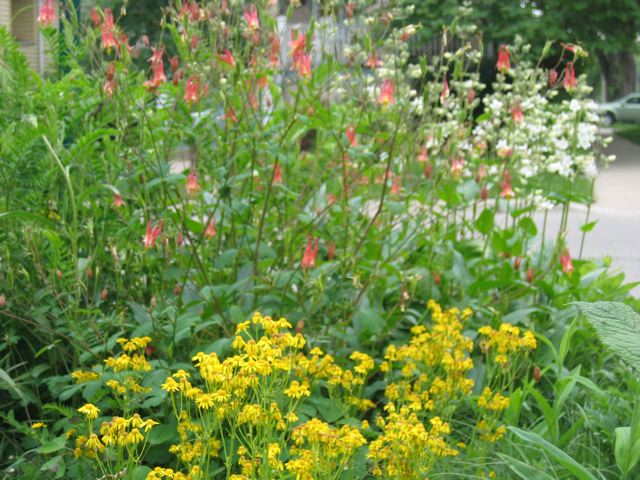By Amy Boruta
Spring is approaching and the snow will soon change to rain. Is your property prone to flooding? Are you prepared to prevent this mishap? There are some simple and natural options that residents around Oak Park are implementing to minimize the threat of local flooding. Two approaches are highlighted in this article -- disconnecting your downspout to prevent rainwater from going into the sewer; and planting native plants which are adapted to the environment and soils in this area. The deep roots of the native plants allow the water to infiltrate into the ground.
Try Disconnecting
One option is to disconnect your gutter downspouts from the sewer line. You can redirect the downspouts to run into your yard. This strategy has the potential of reducing 600 gallons of water from entering the sewer. Eliminating this water from the sewer system can reduce the chances of a back up into lower areas of your home. The Village of Oak Park Public Works Department has created an easy to follow video tutorial on how to connect your downspout. The video, along with additional ideas on what residents can do to reduce the chance of flooding can be found on the Oak Park Village website: http://www.oak-park.us/Publicworks/floodprevention.html.
Let Nature’s Design Work for You
Another alternative is ‘native landscaping’ which is the purposeful use of plants that are native to a specific geographic local in a designed landscape. I spoke to Doug Chien, a local native landscaper that implemented this planting philosophy on his own Oak Park property. Doug provided his perspective of the many benefits of ‘native landscaping’, some examples being flooding reduction and recharging groundwater.
Doug has been interested in protecting and restoring natural areas ever since college. It was only natural that once he had his own plot of land, he would want to replace the non-native lawn with native plants. By native one generally means plants found in an area prior to European settlement. For North East Illinois this would be plants found in the prairie, oak woodlands, and savannas. He often refers to the book "Plants of the Chicago Region" by Swink and Wilhelm, which is considered the definitive guide to North East Illinois ‘native landscaping’.
Roots run deep
Doug has observed that all the rain that falls on his lot now stays since the deep roots of the native plants allow the water to infiltrate into the ground. “Even with our small lot we are able to use small areas planted with natives to hold runoff,” he stated. He adds that many yards have low spots where native vegetation can be planted and the runoff water can be directed. A low spot can also be easily dug to accommodate the runoff rain from the roof.
Doug also enjoys his native plot because he believes it is more engaging and enriching for his family. “I love just crouching down and looking at the complexity and variety of things growing. The look is always changing and there are always different bugs and butterflies. So, we spend more time outside just wandering around and enjoying the yard,” says Doug. His five-year-old daughter loves collecting bugs and flowers found in the vegetation.
Doug encourages others to implement this idea as well because it has numerous benefits for the health of the environment. Native vegetation provides food and shelter for wildlife that is not available with non-natives. His landscaping does not require fertilizer, watering, or mowing and also sequesters carbon. He sees this as an educational opportunity as well. The interesting plants and animals that can be found on his property encourage conversation about the environment with his neighbors. These conversations can lead to others making this type of change and assistant in reducing overall flooding in our community.
Planting a community
Selecting the right plants is very important. Over the years, Doug has tweaked the plants he uses and removes those that get too big. Doug also recommends that those interested follow a key concept when planting a native garden; one must plant a community not a bunch of individual plants. This is an important concept because the flowers and grasses work together to support each other in a native landscape. “If you don't plant enough grasses and sedges your flowers will flop over and leave room for weeds. I suggest a 60% grasses/sedges to 40% flowers”. He also suggests that anyone interested in this type of landscaping consult those with experience.
Doug Chien would be happy to speak with anyone interested in finding out more about this landscaping practices. He can be contacted at dskchien@sbcglobal.net. Some additional resources that Doug recommends include the Chicago Wilderness and the US EPA.
http://www.chicagowilderness.org/sustainable/landscaping_sourcebook.php)




